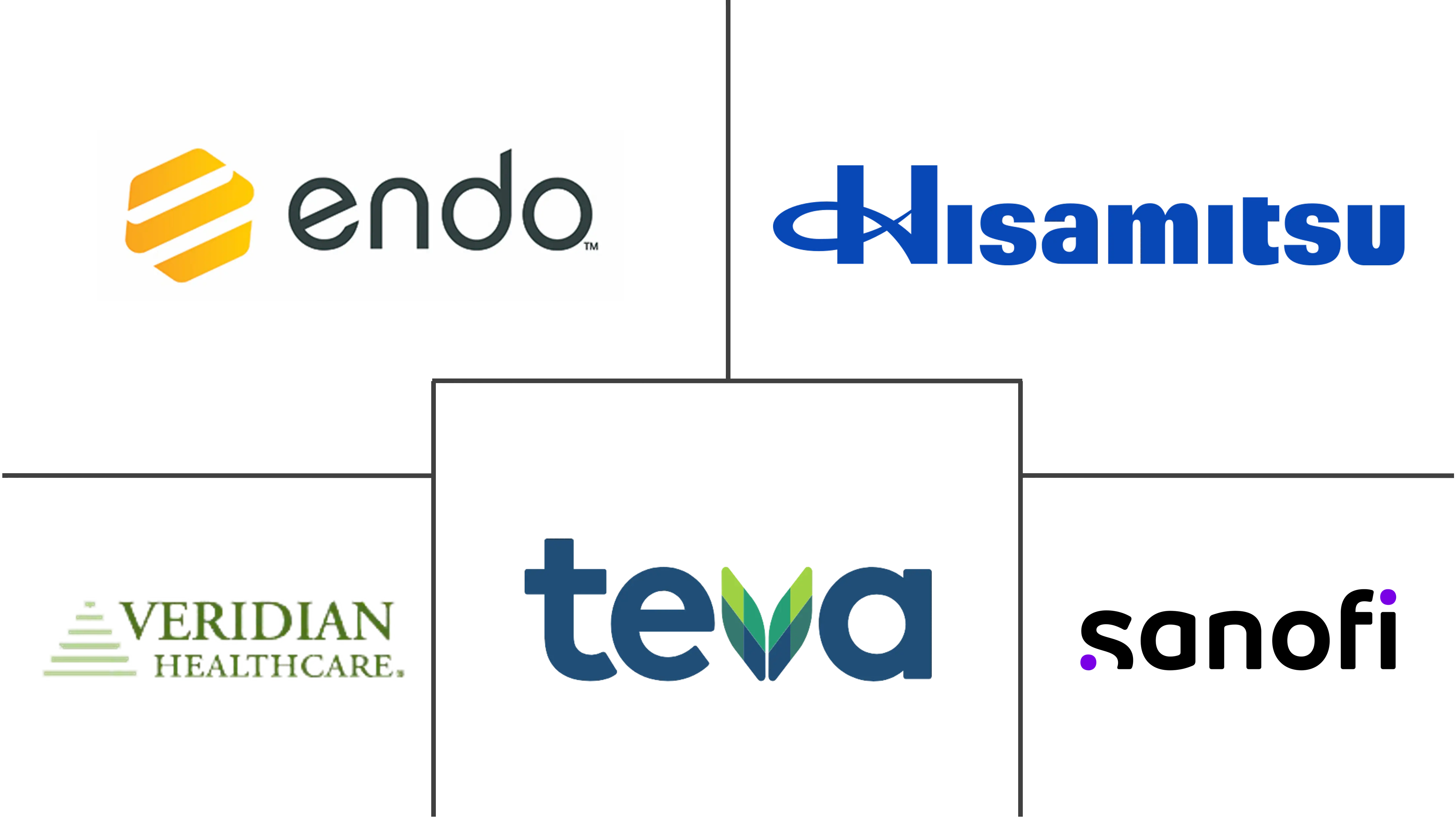Non-opioid Pain Patch Market Size and Share
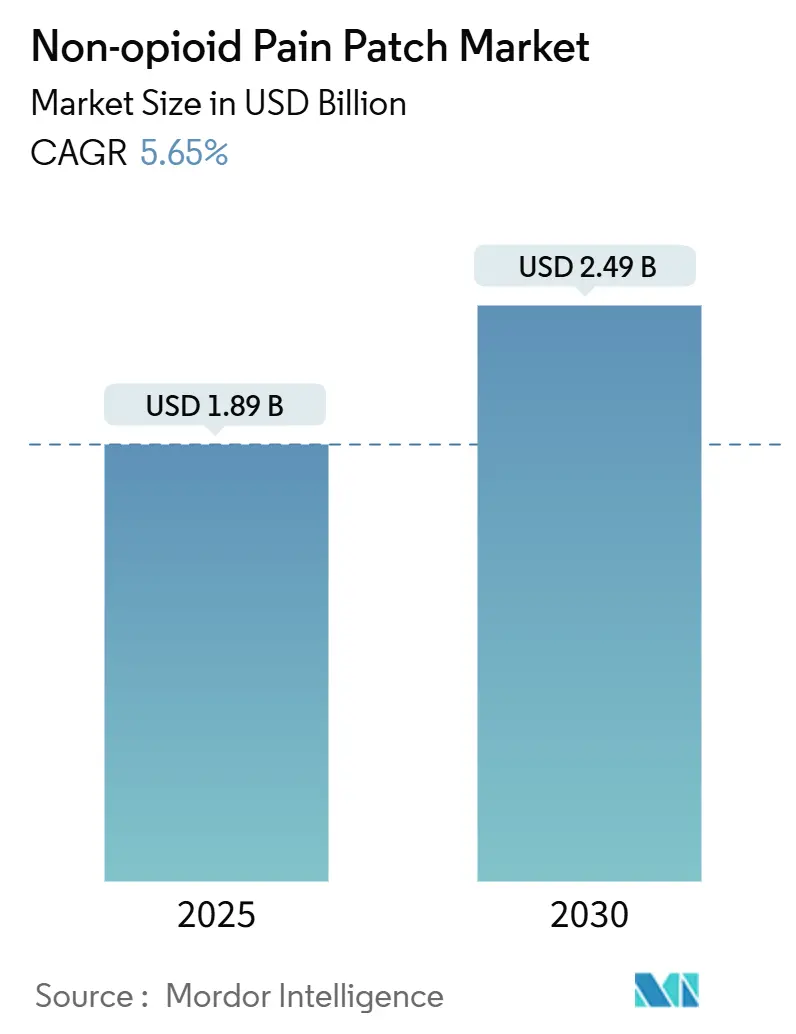
Non-opioid Pain Patch Market Analysis by Mordor Intelligence
The Non-opioid Pain Patch Market size is estimated at USD 1.89 billion in 2025, and is expected to reach USD 2.49 billion by 2030, at a CAGR of 5.65% during the forecast period (2025-2030). Growth is rooted in the global shift away from opioid prescribing, steady innovation in transdermal delivery, and widening reimbursement for topical analgesics. New microneedle-enhanced systems are raising drug-delivery efficiency while large matrix formats preserve cost advantages for established brands. Online pharmacies are reshaping purchase journeys, letting manufacturers build direct bonds with patients and sharpen pricing transparency. Consolidation continues: Grünenthal’s Qutenza licensing deal with Apotex broadened reach in Canada,[1]Source: Grünenthal GmbH, “Apotex Licenses Canadian Rights to Qutenza,” kommunikasjon.ntb.no while smaller firms such as Enokon Medical posted 87% clinical efficacy with natural-ingredient patches that appeal to safety-conscious users.[2]Source: Enokon Medical, “The Rise of Natural Pain Relief Patches,” enokonmedical.com
Key Report Takeaways
- By patch type, lidocaine patches held 35.23% of the non-opioid pain patch market share in 2024; capsaicin patches are projected to expand at a 6.97% CAGR to 2030.
- By technology, matrix patches led with 48.41% revenue share in 2024, while microneedle-enhanced patches record the highest projected CAGR at 7.12% through 2030.
- By indication, neuropathic pain accounted for 37.31% of the non-opioid pain patch market size in 2024 and cancer-associated pain is advancing at a 6.81% CAGR through 2030.
- By distribution channel, retail pharmacies held 44.87% share of the non-opioid pain patch market size in 2024; online pharmacies are forecast to grow at 7.32% CAGR to 2030.
- By geography, North America commanded 39.45% of the non-opioid pain patch market share in 2024, whereas Asia Pacific is set to rise at a 7.87% CAGR during 2025-2030.
Global Non-opioid Pain Patch Market Trends and Insights
Drivers Impact Analysis
| Driver | (~) % Impact on CAGR Forecast | Geographic Relevance | Impact Timeline |
|---|---|---|---|
| Rising burden of pain-related disorders | +1.2% | Global, higher in North America and Europe | Long term (≥ 4 years) |
| Technological advances in transdermal delivery | +1.8% | North America, Europe, Japan | Medium term (2-4 years) |
| Growing consumer preference for OTC analgesics | +0.8% | Global, early in North America and Europe | Medium term (2-4 years) |
| E-commerce and direct-to-consumer expansion | +1.0% | North America, Europe, urban APAC | Short term (≤ 2 years) |
| Regulatory shift toward non-opioid analgesics | +1.4% | North America, spillover to Europe | Medium term (2-4 years) |
| Surge in sports injuries | +0.6% | Global, higher in North America and Europe | Short term (≤ 2 years) |
| Source: Mordor Intelligence | |||
Rising burden of pain-related disorders
More than 1.5 billion people live with chronic pain, and aging societies push neuropathic conditions to the forefront. Diabetes alone is set to affect 783 million adults by 2045, swelling the pool of patients with diabetic peripheral neuropathy. Productivity losses tied to unmanaged pain top USD 300 billion each year in the United States. Payers and clinicians therefore favor localized, low-risk treatments that keep patients active and reduce reliance on systemic drugs.
Technological advances in transdermal delivery
Fourth-generation patches now integrate microneedles that bypass the tough outer skin layer and release analgesics in a controlled manner. Polymer-based microneedle arrays with porous coatings deliver three-times higher loads than metal designs and extend pain-relief duration. Such gains address prior limits for hydrophilic drugs and cut application frequency, raising patient adherence.
Growing consumer preference for OTC analgesics
Heightened awareness of opioid risks and common NSAID side effects steers shoppers toward self-care solutions with minimal systemic exposure. Branded OTC patches highlight drug-in-adhesive builds, longer wear time, and skin-friendly ingredients to win repeat purchase. The trend also encourages premium pricing for advanced formulations with menthol or natural extracts.
E-commerce and direct-to-consumer expansion
Online pharmacies grow faster than any other channel, letting users compare prices and read peer reviews before buying. Subscription models offer refill reminders and bundle pain-management education. Manufacturers leverage digital campaigns to target niche groups such as marathon runners or post-surgical patients, accelerating brand visibility at lower cost than in-store promotions.
Restraints Impact Analysis
| Restraint | (~) % Impact on CAGR Forecast | Geographic Relevance | Impact Timeline |
|---|---|---|---|
| Price sensitivity vs low-cost oral drugs | -0.9% | APAC, Africa, Latin America | Medium term (2-4 years) |
| Complex regional regulatory hurdles | -0.7% | Global, higher in Europe and Japan | Short term (≤ 2 years) |
| Competition from alternative non-opioid therapies | -0.6% | North America, Europe | Medium term (2-4 years) |
| Humidity-linked shelf-life issues | -0.4% | ASEAN, tropical regions | Long term (≥ 4 years) |
| Source: Mordor Intelligence | |||
Price sensitivity versus low-cost oral analgesics
In many emerging countries a branded patch costs five-to-ten times more than generic ibuprofen tablets. Limited insurance coverage prompts patients to opt for the cheapest immediate relief. India’s drug-makers hope to bridge this gap by launching generic patches as patents expire on over 300 products by 2030, yet near-term affordability hurdles stay in place.
Complex regional regulatory hurdles
Skin-sensitization studies demanded by the European Medicines Agency and Japan’s PMDA often exceed FDA requirements, stretching development cycles and budgets. Smaller firms struggle to fund parallel submissions, slowing global roll-outs. Microencapsulation and hypoallergenic adhesives help cut irritation but still require region-specific testing.
Segment Analysis
By Patch Type: Lidocaine commands share while capsaicin accelerates
Lidocaine products held the largest slice of the non-opioid pain patch market size at 35.23% in 2024, supported by decades of clinical use and broad third-party payment. Strong safety and minimal systemic absorption make lidocaine popular in elderly populations, which are most affected by post-herpetic neuralgia. Grünenthal and Scilex broadened acceptance by delivering thinner, high-adhesion systems that permit exercise and showering without detachment.
Capsaicin patches expand at a 6.97% CAGR, the fastest among patch types, because high-concentration formulations produce multi-month relief from diabetic neuropathy and chemotherapy-induced pain. Older patients achieved statistically significant pain score reductions in a 2025 study that compared capsaicin to standard care. Diclofenac and ketoprofen hold niche roles in musculoskeletal injury management, while natural-ingredient patches from Enokon create a small but visible frontier for chemical-free therapy seekers.
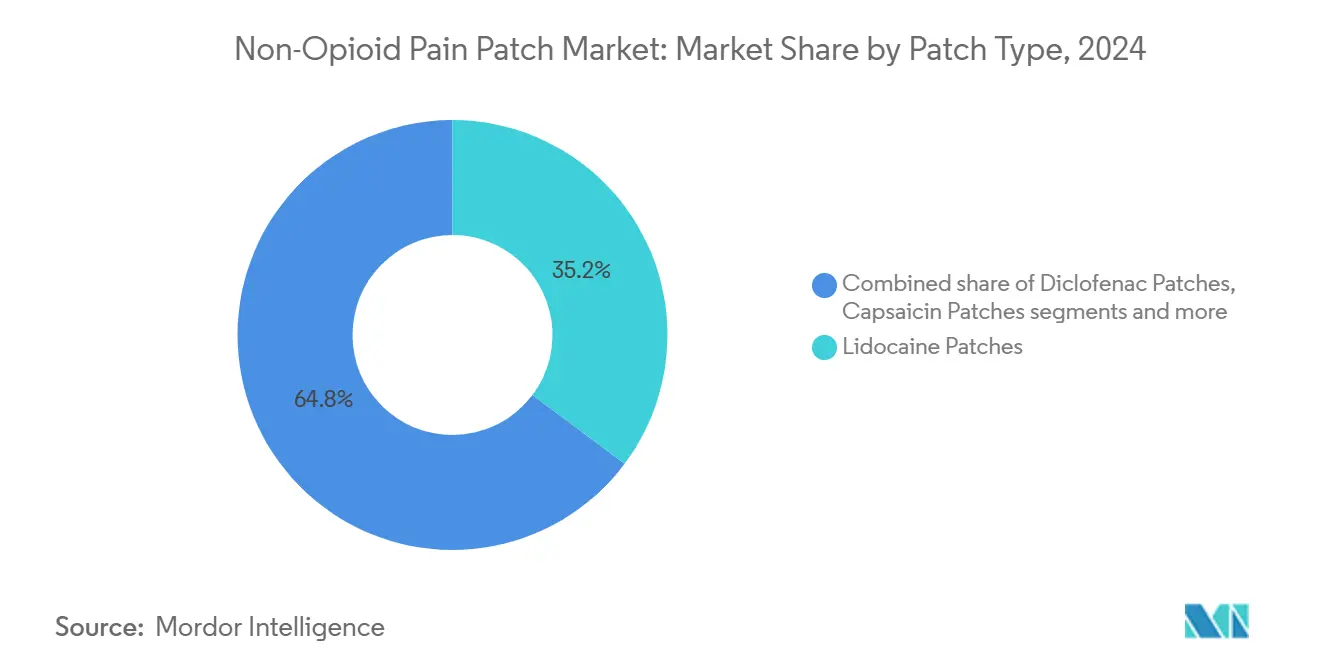
Note: Segment shares of all individual segments available upon report purchase
By Technology: Matrix retains lead; microneedle systems surge
Matrix construction accounted for 48.41% of the non-opioid pain patch market share in 2024. Manufacturers prefer the format because it supports a wide range of APIs at reasonable production cost. Hospitals value the steady plasma levels delivered over 12-24 hours.
Microneedle-enhanced patches post the highest growth at 7.12% CAGR, capitalizing on their ability to open microchannels that improve permeation of hydrophilic molecules like gabapentin. A 2024 carbon-master microneedle prototype raised delivery efficiency threefold compared with earlier metal units.[3]Source: Choi H.J. et al., “Microneedle Patch Casting Using a Micromachined Carbon Master for Enhanced Drug Delivery,” Sci Rep, nature.com Reservoir systems stay relevant in long-wear chronic treatment, and drug-in-adhesive sheets secure cosmetic appeal with ultra-thin designs. Smart pH-responsive microneedle arrays represent the next wave, adjusting dose to local inflammation levels.
By Indication (Pain Type): Neuropathic pain leads opportunities
Neuropathic disorders represented 37.31% of the non-opioid pain patch market size in 2024. Post-herpetic neuralgia and diabetic neuropathy remain the most common uses because they benefit from localized, sustained delivery. New guidelines in major oncology centers now recommend capsaicin patches against chemotherapy-induced neuropathy, expanding eligible patient pools.
Cancer-associated pain posts a 6.81% CAGR and stands as the fastest-growing indication, fueled by longer cancer survival and a need to control neuropathic flares without opioids. Musculoskeletal pain retains a substantial share thanks to high sports injury rates, while postoperative pain scripts grow after hospitals adopt topical protocols to cut opioid days.
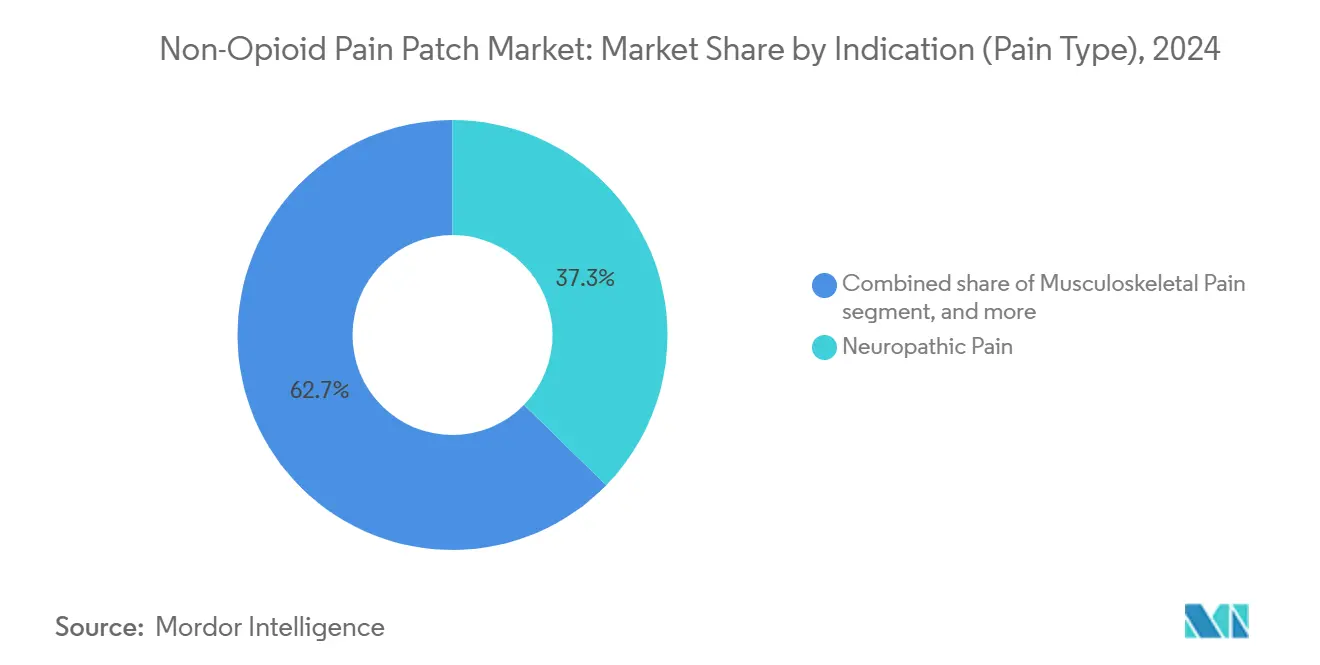
Note: Segment shares of all individual segments available upon report purchase
By Distribution Channel: Retail leads, online disrupts
Retail pharmacies captured 44.87% of non-opioid pain patch market share in 2024, offering immediate access and pharmacist counseling. Chain stores run loyalty programs that bundle patches with heat wraps or topical gels to deepen wallet share.
Online pharmacies grow at 7.32% CAGR as broadband coverage widens. Platforms showcase detailed video demos, ingredient lists, and user feedback that improve confidence among first-time buyers. Pain Relief Technologies markets its Kailo patch exclusively online, offering 60-day money-back guarantees and installment plans that lower entry cost. Hospital pharmacies continue to serve prescription-only formulations, especially for new neurological diagnoses, while omnichannel pilots link in-store pick-up with home-delivery autoship.
Geography Analysis
North America contributed 39.45% of 2024 revenue, reflecting widespread awareness of opioid addiction risks and generous payer coverage for topical analgesics. The 2025 NOPAIN Act funds non-opioid postoperative options, driving hospital uptake of capsaicin and lidocaine systems. U.S. FDA approvals of novel non-opioid treatments also boost clinician confidence FDA.
Asia Pacific posts the fastest regional CAGR at 7.87% through 2030. Japan’s super-aged society faces high rates of post-herpetic neuralgia, and reimbursement committees increasingly reimburse capsaicin 8% patches for long-term relief. In China and India growth hinges on price negotiation; domestic contract manufacturers prepare low-price generics that could widen access once global patents expire.
Europe holds a solid share with strong chronic-pain management frameworks but slower growth because the EMA demands extra skin-sensitization tests. Germany, the United Kingdom, and France incentivize e-prescriptions, easing digital pharmacy adoption. Latin America and the Middle East show moderate growth when private insurers reimburse branded patches in tier-one cities. Humid ASEAN climates challenge supply chains because high moisture shortens shelf life, prompting foil-laminated sachets and desiccant liners.
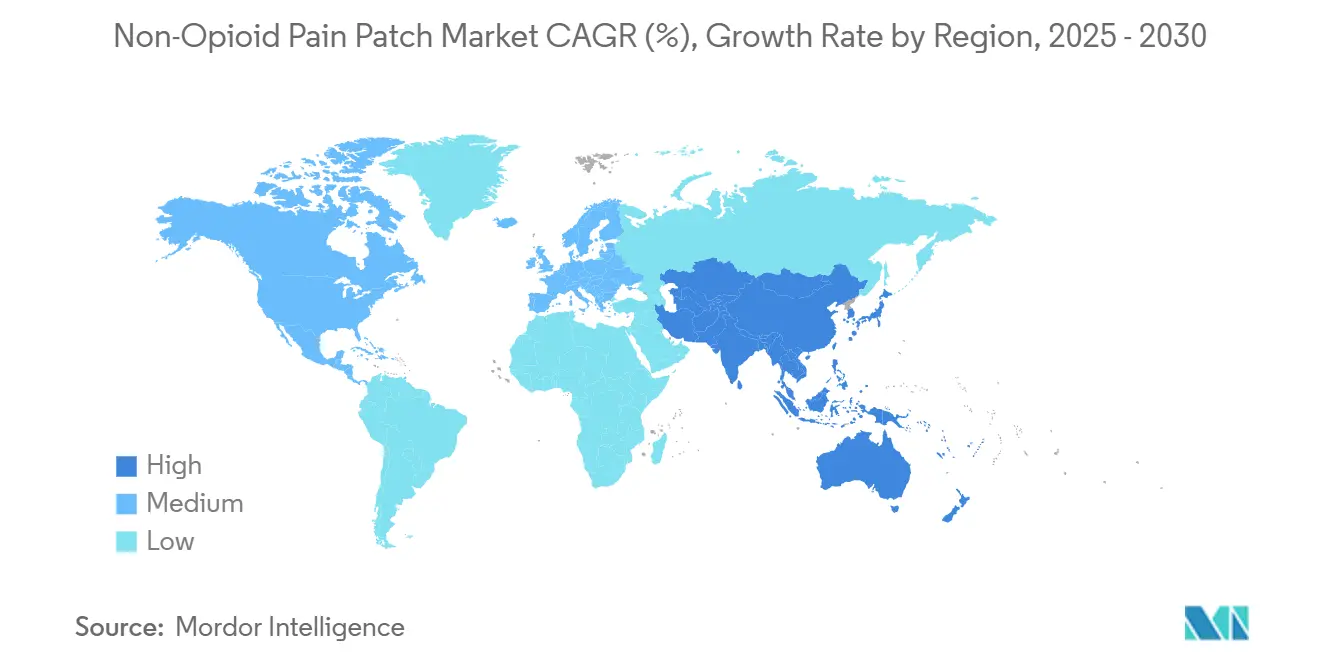
Competitive Landscape
The non-opioid pain patch market shows moderate concentration. The key players of the market include Grünenthal, Scilex, Teva, Hisamitsu, and Endo. Grünenthal deepens penetration of its Qutenza capsaicin brand through co-promotion with Apotex in Canada, expanding formulary placements in hospital outpatient care. Scilex won share with ZTlido, a lidocaine 1.8% system that sticks through exercise and showering; retrospective claims data show 51.9% of users cut or stopped opioids within months.
Innovators pursue microneedle designs that support high-load gabapentin or combinations of lidocaine and menthol. Device-based entrants such as Kailo employ bioelectric fields rather than active drugs, yet still compete for the same consumer budgets. Midsize firms explore hybrid models that pair patches with digital companion apps for pain tracking and refill reminders.
White-space lies in advanced adhesion chemistries that tolerate perspiration, personalized dose packs based on digital pain diaries, and combination therapy that blends capsaicin with low-dose NSAIDs to attack multiple pain pathways. Cross-licensing and regional distribution deals are expected as multinational firms seek presence in high-growth APAC markets without building full infrastructure.
Non-opioid Pain Patch Industry Leaders
-
Hisamitsu Pharmaceutical Co. Inc.
-
Teva Pharmaceuticals Industries Ltd.
-
Veridian Healthcare
-
Sanofi
-
Endo International plc
- *Disclaimer: Major Players sorted in no particular order
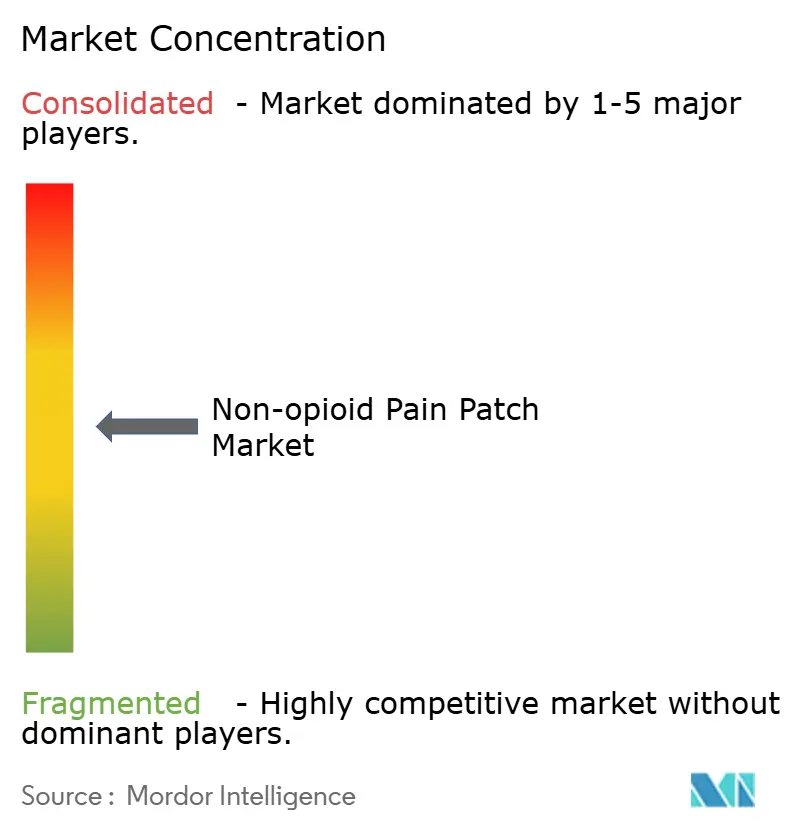


Recent Industry Developments
- April 2025: Grünenthal reported EUR 1.8 billion revenue, with Qutenza sales up 25% year on year.
- October 2024: Scilex Holding Company began exploring a spinoff or public listing of Scilex Pharmaceuticals to unlock shareholder value .
- April 2024: Grünenthal completed recruitment for a Phase III trial of Qutenza in postsurgical neuropathic pain; results are due Q4 2025.
- January 2024: Pain Medicine News published real-world data showing ZTlido users cut opioid consumption more than those on 5% lidocaine patches.
Research Methodology Framework and Report Scope
Market Definitions and Key Coverage
According to Mordor Intelligence, we define the non-opioid pain patch market as transdermal products that deliver lidocaine, diclofenac, capsaicin, ketoprofen, or related non-narcotic actives through intact skin to block or dampen pain signaling in chronic or acute conditions. The study values only factory-made commercial patches sold via prescription or over-the-counter channels across 17 major countries.
Scope exclusion: experimental polymer films, compounded in-clinic dressings, and any opioid-containing patches sit outside our count.
Segmentation Overview
- By Patch Type
- Lidocaine Patches
- Diclofenac Patches
- Capsaicin Patches
- Ketoprofen Patches
- Other Patch Types
- By Technology
- Matrix Patches
- Reservoir Patches
- Drug-in-Adhesive Patches
- Microneedle-Enhanced Patches
- By Indication (Pain Type)
- Neuropathic Pain
- Musculoskeletal Pain
- Cancer-Associated Pain
- Others (Headache, Dental, Post-op)
- By Distribution Channel
- Hospital Pharmacies
- Retail Pharmacies
- Online Pharmacies
- By Geography
- North America
- United States
- Canada
- Mexico
- Europe
- Germany
- United Kingdom
- France
- Italy
- Spain
- Rest of Europe
- Asia-Pacific
- China
- Japan
- India
- Australia
- South Korea
- Rest of Asia-Pacific
- Middle East and Africa
- GCC
- South Africa
- Rest of Middle East and Africa
- South America
- Brazil
- Argentina
- Rest of South America
- North America
Detailed Research Methodology and Data Validation
Primary Research
We spoke with pain specialists, hospital pharmacists, retail chain buyers, and regional distributors spanning North America, Europe, China, Japan, and India. Their insight fine-tuned adoption rates, replacement cycles, and average patch counts per therapy episode, which in turn anchored assumptions taken from desk work.
Desk Research
Our analysts first reviewed authoritative public datasets such as the CDC's National Health Interview Survey, the International Association for the Study of Pain prevalence dashboards, FDA 510(k) and NDA approval logs, Eurostat hospital discharge files, and UN Comtrade shipment codes for medicated adhesive dressings. Trade association briefings from the US Pain Foundation and European Pain Federation helped us map use cases, while company 10-Ks, investor decks, and local price lists clarified typical selling prices.
Subscription repositories, such as Dow Jones Factiva for news flow, D&B Hoovers for manufacturer revenues, and Questel for patent intensity, supplied additional signals on pipeline launches and competitive intensity. This list is illustrative; many other public and proprietary sources were reviewed in building the evidence stack.
Market-Sizing & Forecasting
A top-down prevalence-to-treated-cohort build combined global chronic pain incidence with physician treatment rates and patch penetration. Selective bottom-up supplier revenue roll-ups and sampled ASP × volume checks validated and adjusted the totals. Key variables in the model include chronic neuropathic pain prevalence, prescription opioid volume decline, annual FDA non-opioid patch clearances, average retail price per 10-count box, and e-commerce share of topical analgesic sales. Multivariate regression projects these drivers to 2030, after which scenario analysis tests upside from microneedle platforms and downside from pricing pressure. Data gaps in manufacturer roll-ups were bridged using regional import values and verified clinical usage ratios.
Data Validation & Update Cycle
Model outputs pass three layers of variance checks, peer review, and senior sign-off. We refresh figures every twelve months, triggering interim updates when material events, such as product recalls, major approvals, and reimbursement shifts, move the needle. A final analyst pass ensures clients receive the most current viewpoint before release.
Why Mordor's Non-opioid Pain Patch Baseline Is Dependable
Published estimates often differ because firms choose distinct patch lists, geographies, and pricing yardsticks. Our disciplined scoping, live primary inputs, and annual refresh cadence narrow those gaps for decision-makers.
Key gap drivers include some studies that tally only prescription sales, others that mix heat wraps and herbal plasters, while a few inflate values by applying wholesale mark-ups to retail volumes without country-level currency adjustments.
Benchmark comparison
| Market Size | Anonymized source | Primary gap driver |
|---|---|---|
| USD 1.89 B (2025) | Mordor Intelligence | |
| USD 0.83 B (2023) | Global Consultancy A | Limited country scope and excludes OTC e-commerce sales |
| USD 8.10 B (2022) | Trade Journal B | Broad inclusion of topical heat wraps and multi-ingredient plasters |
| USD 1.00 B (2025) | Industry Association C | Focuses on lidocaine and capsaicin only; omits emerging microneedle formats |
The comparison shows that Mordor's balanced, transparent approach, grounded in clear product boundaries and repeatable top-down checks, offers a dependable baseline for strategic planning.


Key Questions Answered in the Report
Which technology trend is most likely to reshape the non-opioid pain patch market over the next five years?
Microneedle-enhanced patches are set to redefine delivery efficiency by opening micro-channels in the skin that improve permeation of hydrophilic analgesics, extending wear time and reducing application frequency.
Why are capsaicin patches gaining momentum among clinicians treating neuropathic pain?
High-concentration capsaicin provides multi-month relief with a single application, giving physicians a non-systemic option for difficult-to-treat neuropathies such as post-herpetic neuralgia and chemotherapy-induced pain.
How is the rise of online pharmacies influencing competitive strategies for patch manufacturers?
Digital channels enable direct-to-consumer engagement, allowing brands to bundle education, subscription refills and targeted promotions that bypass traditional retail mark-ups.
What regulatory development in the United States is expected to accelerate hospital adoption of topical analgesic patches?
The NOPAIN Act mandates Medicare coverage for non-opioid pain alternatives in outpatient settings, prompting hospitals to integrate patches into perioperative pain protocols.
Which patient demographic is driving sustained demand for lidocaine-based patches?
Older adults, particularly those with co-morbidities that limit systemic NSAID use, prefer lidocaine patches for their favorable safety profile and minimal drug interactions.
Where do white-space opportunities exist for new entrants in this market?
Innovative combinations that unite multiple active ingredients or pair patches with mobile apps for personalized dosing offer untapped potential for differentiation.
Page last updated on:
